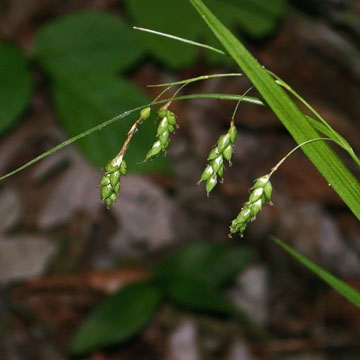

Carex formosa - (image 1 of 4)
Taxonomy
Family: Cyperaceae
Section Hymenochlaenae
Habitat
Mesic to dry calcareous woods, ravines, moist meadows.
Associates
Distribution
MA, CT, and southern Quebec to MI, WI, and ND.
Morphology
Tufted perennial, 30-70 cm, strongly purplish at the base; main leaves 3-7 mm wide, hairy beneath; sheaths hairy at least on the back; terminal spike with a few distal perigynia; lateral spikes pistillate, with a few basal staminate flowers, well separated, cylindric, 1-3 cm long and 5 mm wide, densely many-flowered, erect or spreading, on peduncles about as long; bracts all sheathing, the uppermost much reduced; pistillate scales ovate to obovate, slightly shorter than the perigynia, obtuse to acuminate or cuspidate; perigynia ovoid, 4-5 mm and half as wide, obtusely trigonous, sharply several-nerved, acuminately narrowed to a distinct beak; achene sharply and concavely trigonous.
Notes
Fruiting June to July
Wetland indicator: FAC
This species has shorter pistillate spikes with fewer perigynia than other members of section Hymenochlaenae. Rare to endangered in all U.S. states in which it is found. Ontario seems to be the only place that it is considered to be secure.
References
Gleason, Henry A. and A. Cronquist. 1991. Manual of Vascular Plants of
Northeastern United States and Adjacent Canada. Second Ed.
The New York Botanical Garden. Bronx, NY
|
© Michael Hough 2018 |